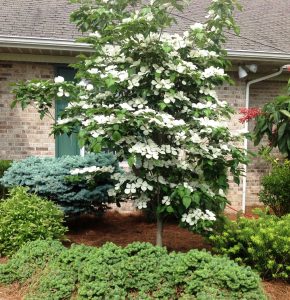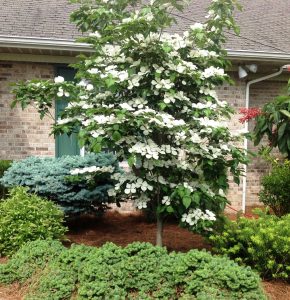When to trim a dogwood tree?
Dogwood trees are known for their beautiful blossoms and unique bark. To keep them healthy and beautiful, they must be trimmed at the appropriate time and properly. ArborTrueCA will guide you on when to trim dogwood trees over the best techniques for cutting them so they can thrive for years to come.
Why Trimming Is Important?
Trimming your dogwood tree is necessary for a variety of reasons. Regular trimming contributes to:


Promote Health: Eliminating dead or diseased branches reduces the spread of diseases.
Enhance Appearance: Properly formed trees are more appealing.
Encourage Growth: Pruning promotes new growth, resulting in a larger canopy.
Improve Air Circulation: Thinning out the tree allows for greater air circulation, which reduces the danger of fungal illnesses.
Understanding the Dogwood Tree Growth Cycles
Before delving into the ideal trimming times, it’s critical to understand the growth cycles of dogwood trees. These trees have various periods of hibernation, active development, and flowering, which all contribute to choosing the best pruning strategy.
Dormancy Period
Dogwood trees go dormant in late fall and winter. During this phase, the tree’s metabolic activity slows and it conserves energy. This season is critical for planning significant trimming operations since it reduces stress on the tree.
Active Growth Period
Dogwood trees break out of hibernation in early spring and begin to grow actively. New leaves, branches, and blooms begin to emerge, and the tree requires plenty of nutrients and water to support this growth.
Blooming Season
Dogwood trees are known for their stunning spring blossoms, which usually occur in April or May. These blossoms are not only visually appealing, but they also attract pollinators, which aid in the tree’s reproductive cycle.
The best time to trim dogwood trees
When to trim Dogwood Tree?
late winter to early spring
The best time to prune dogwood trees is in late winter or early spring, just as new growth begins. During this time, the tree is dormant, making trimming less stressful for it. Furthermore, the lack of leaves allows you to easily examine the tree’s structure, making it easier to detect and remove problem branches.
Avoiding the Flowering Season
Dogwood trees blossom in the spring, producing stunning flowers that are one of its main draws. Pruning during the flowering season might diminish the amount of blossoms and take away their attractiveness. As a result, it is recommended to complete the pruning before the tree begins to flower.
Summer pruning
Summer is a good time to undertake some pruning, such as removing dead or damaged branches. However, heavy pruning should be avoided during this period because it might stress the tree and make it more vulnerable to pests and diseases.
How to Trim a Dogwood Tree?
Gathering the Right Tools
Before you start cutting, make sure you have the proper tools:
Pruning Shears: For tiny branches.
Loppers are for medium-sized branches.
Pruning Saw: For bigger branches.
Gloves and safety equipment: To protect yourself.
Steps for trimming
Check for any dead, sick, or damaged branches. These should be your initial targets.
Make smooth, slight-angle cuts with sharp instruments. This allows the tree to heal faster.
Remove suckers and water sprouts, which are robust shoots that grow from the Removing them redirects the tree’s energy toward healthy growth.
Remove any overloaded branches to promote air circulation and light penetration.
Trim branches to keep the tree in a balanced, visually pleasing shape.
Common Mistakes to Avoid
Over-Pruning
Excessive trimming can weaken a dogwood tree, increasing its susceptibility to diseases and pests. Follow the basic rule of removing no more than 25% of the tree’s canopy in a single year.
Incorrect timing
As previously said, timing is essential. Pruning at the wrong time might diminish blooming and cause stress in the tree. For large-scale pruning, wait until late winter or early spring.
Improper Cuts
Avoid flush cuts (cuts too near to the trunk or primary branches) and stub cuts (cuts too distant from the main branches). Both can cause poor healing and increase the likelihood of infection.
Post-trimming Care
Watering & Mulching
After pruning, deeply water your dogwood tree to aid in its recovery. Mulching around the base conserves moisture and regulates soil temperature.
Fertilizing
Consider using a balanced fertilizer in early spring to encourage healthy growth. However, avoid over-fertilizing, as this can result in an abundance of leaves rather than blooms.
Monitoring for pests and diseases
Monitor your tree for symptoms of pests or illnesses. Early discovery and treatment are critical to preserving the tree’s vitality.
Related Posts:
FAQS
1. May I cut my dogwood tree in the fall?
It is better to avoid fall trimming since it can promote new growth that may not harden before winter, leaving it vulnerable to injury.
2. How much should I prune my dogwood?
To reduce stress and promote healthy growth, aim to remove no more than 25% of the tree’s canopy in one year.
3. Can I trim a dogwood tree myself, or do I need to call a professional?
While basic trimming operations can be completed on your own, consider hiring a professional for larger or more difficult pruning jobs to avoid injuring the tree.
4. What are the indicators of excessive pruning?
Over-pruning is characterized by thin leaves, excessive water sprout growth, and a generally weaker appearance.
5. How frequently should I cut my dogwood tree?
Regular annual trimming is usually sufficient, but you should also monitor your tree for problems that need to be addressed more frequently.
By following these rules, you can keep your dogwood tree healthy and lovely, adding to the scenery of your garden for years to come.
Conclusion
Trimming dogwood trees at the appropriate time and way is critical for their health, growth, and aesthetic appeal. Major pruning is best done between late winter and early spring when the tree is dormant and less stressed. Light pruning can also be done in the summer to eliminate dead or diseased branches. Avoid pruning in the fall to avoid promoting new growth that may be damaged by winter conditions. By following these rules and performing correct post-pruning maintenance, you can keep your dogwood tree looking beautiful and healthy in your environment.



